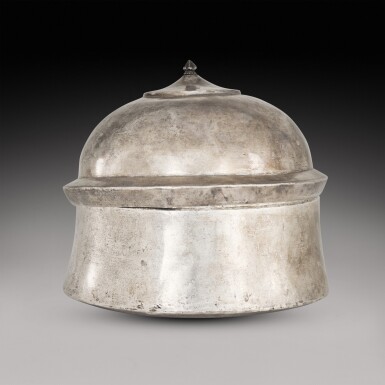The Edith & Stuart Cary Welch Collection: Online
The Edith & Stuart Cary Welch Collection: Online

A silver pandan, India, Deccan, 17th century or later
Lot Closed
October 27, 01:32 PM GMT
Estimate
1,500 - 2,000 GBP
Lot Details
Description
of cylindrical waisted form with a slightly convex base, the domical cover with an inverted rim and fluted knop finial, later punched letters and numbers in devanagari, on the cover and twice on the body
19.8cm. diam.
The elegant plain form is immediately reminiscent of the domed architecture of the Deccani Sultanates. This architectural inspiration is shared with a larger group of pandans, several of which are in bidriware of the 17th century (Zebrowski, M., Gold, Silver and Bronze from Mughal India, London 1997, p.266, nos.452, 453 and 454). The use of architectural forms on metal boxes may be inherited from medieval Persian practice but an awareness of contemporary dome forms is apparent in the Deccani examples (ibid., p.264).
The chewing of pan involves the mixing of thin slices of the nut of the areca palm with lime paste enveloped in a fresh leaf of the betel tree (ibid., p.263). The associations of the habit with a leisurely lifestyle imbued it with connotations of courtly life. In a miniature of 1570, depicting the Sultan of Ahmadnagar, the use of pan seems to be used as emblematic of royal status (Bibliothèque Nationale, Paris, inv.no.Supplément persan 1572, fol.26). In a relatively large container such as this, with no internal divisions, it is assumed that its purpose was the storage of the unassembled materials for betel chewing.
You May Also Like










